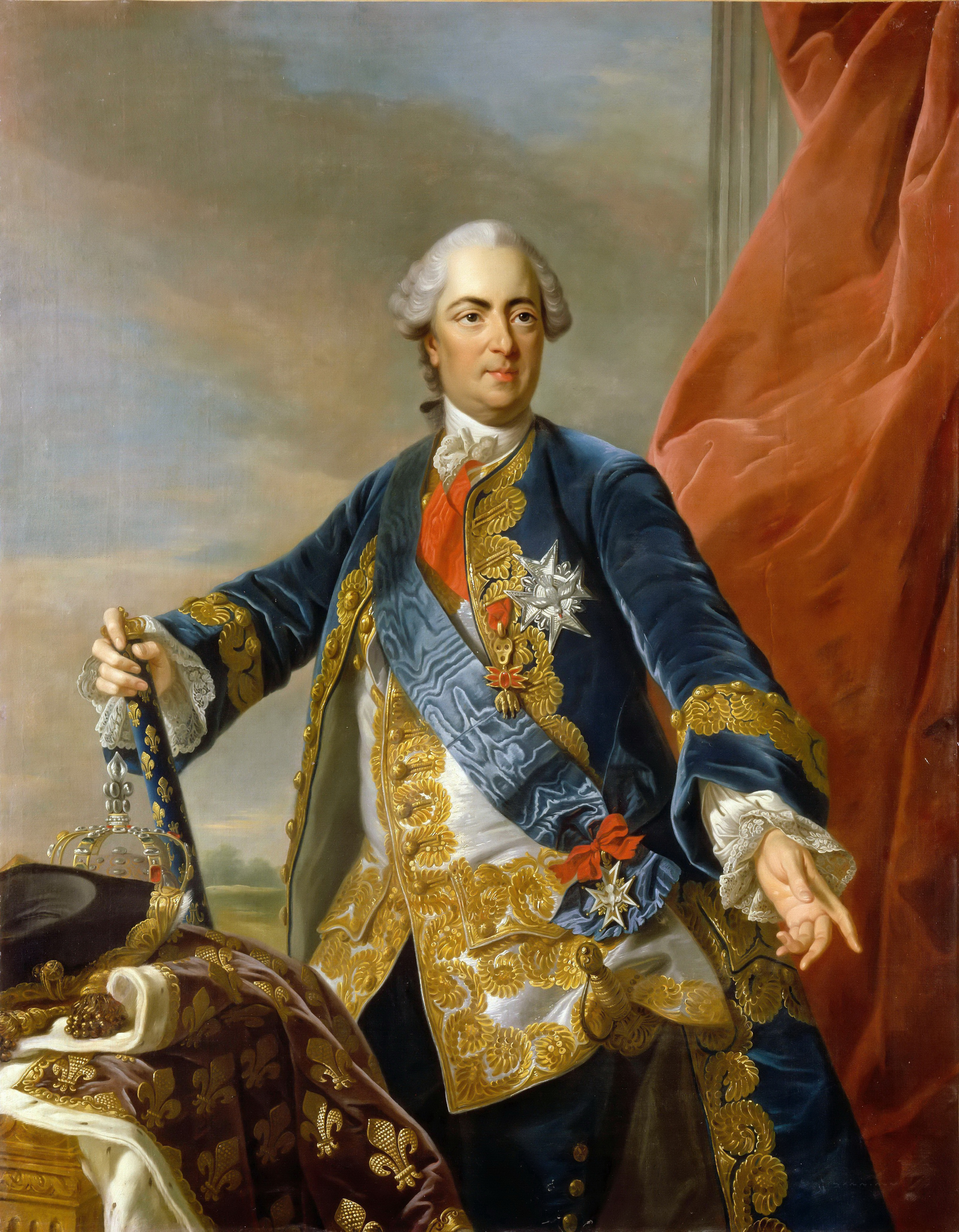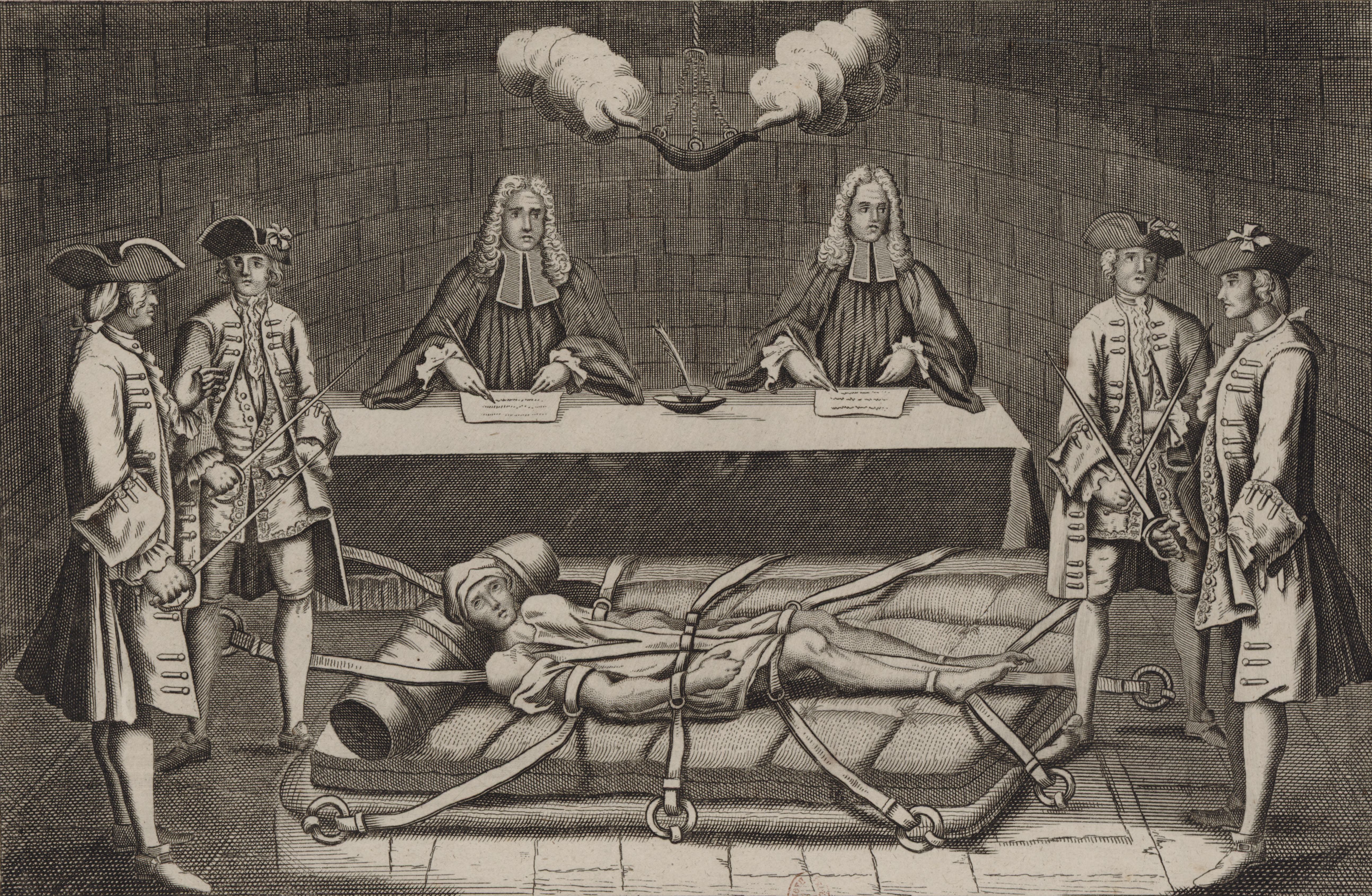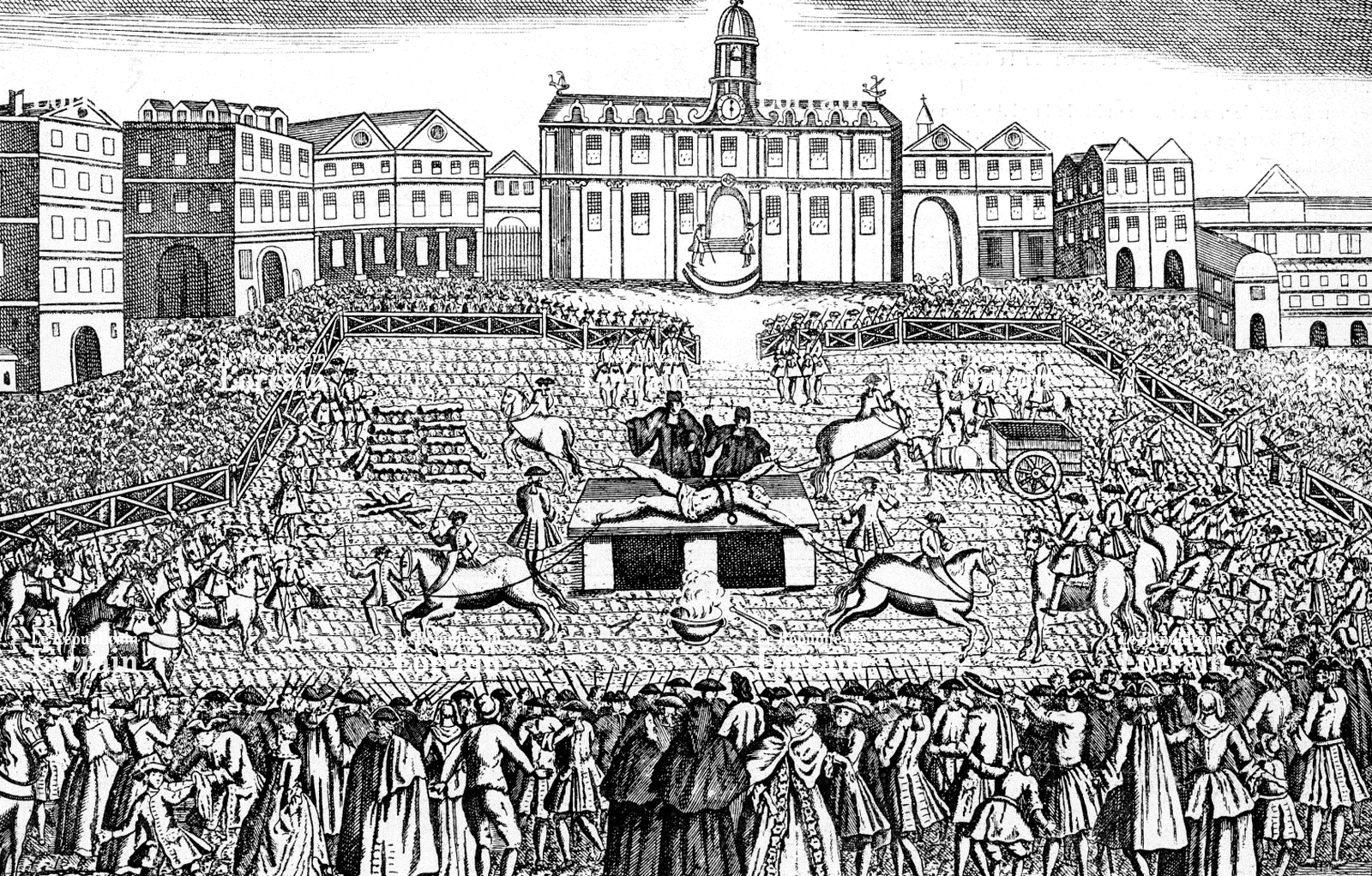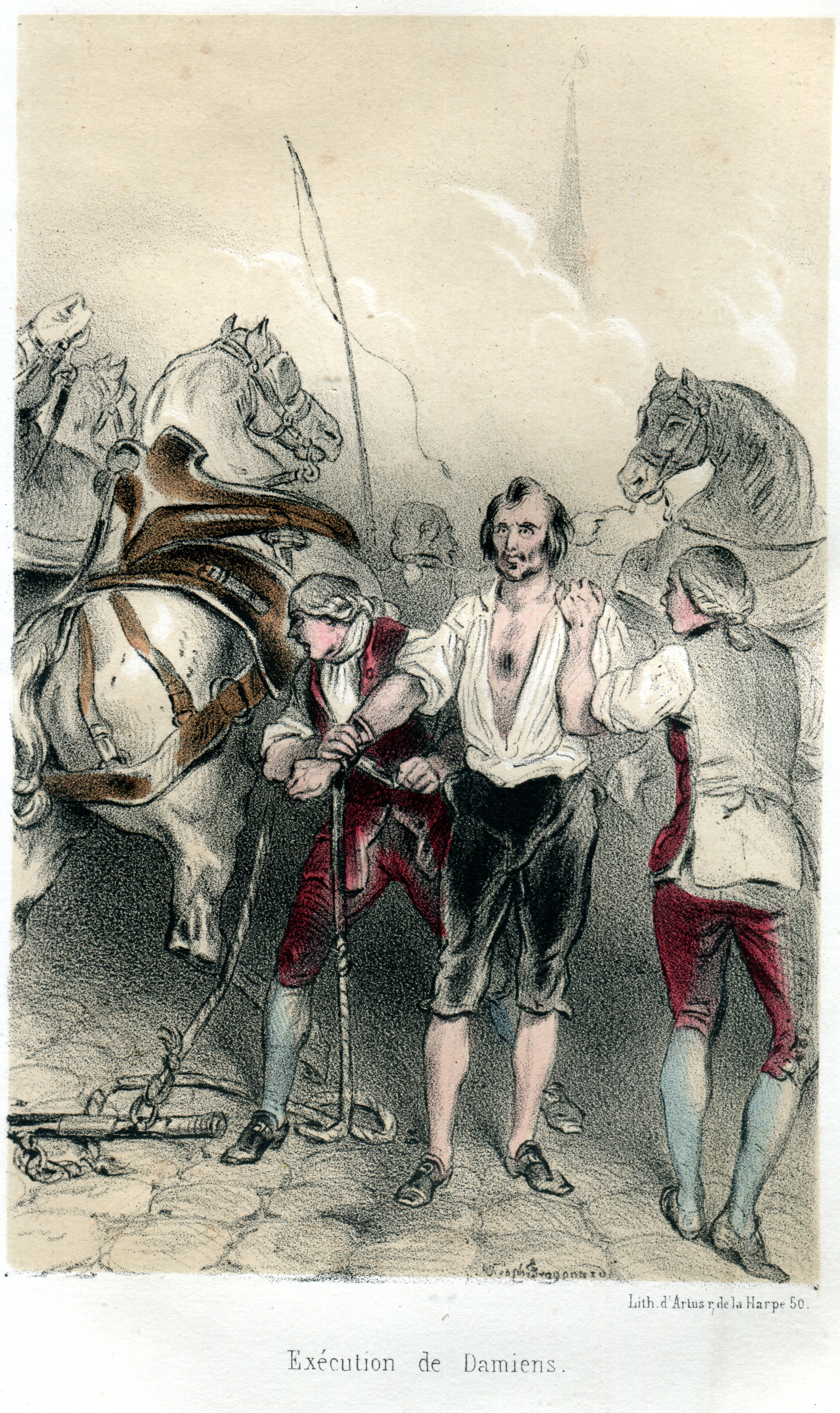1. Early life and background
Robert-François Damiens's early life was marked by a humble background and a series of employments from which he was often dismissed for misconduct, contributing to his controversial reputation.
1.1. Birth and childhood
Damiens was born on January 9, 1715, in La Thieuloye, a village located near Arras in northern France. He was the eighth of ten children. His father earned a living as a day laborer and, at times, as an executioner. Damiens was raised by his uncle in Béthune.
1.2. Military service and employment
Damiens enlisted in the army at an early age and participated as an unknown soldier in the Siege of Philippsburg (1734). After his discharge from military service, he became a domestic servant. He worked at the college of the Jesuits in Paris, specifically at Lycée Louis-le-Grand. However, he was dismissed from this position, as well as from other subsequent employments, due to misconduct. He was known to have absconded with money from the Jesuit college. His behavior earned him the moniker Robert le DiableFrench, meaning "Robert the Devil."
1.3. Motivations for the crime
Damiens's motivations for attempting to assassinate King Louis XV have been widely debated, with some historians suggesting he may have been mentally unstable. During his interrogations, Damiens appeared to be agitated by the widespread public uproar following the French Catholic clergy's refusal to administer holy sacraments to members of the Jansenist sect. Damiens himself sympathized with Jansenism and harbored resentment towards Pope Clement XI's suppression of Jansenism and the Convulsionaries, a faction within the movement. He seemed to hold King Louis XV ultimately responsible for this religious repression and consequently formulated a plan to punish the monarch. According to some accounts, his intention was to merely wound the king and observe the color of his blood, driven by the religious sentiments of the era.
2. Assassination attempt
On a cold winter day in January 1757, Robert-François Damiens carried out his attack on King Louis XV at the Palace of Versailles, an event that shocked the French court and nation.
2.1. Course of the event
On January 5, 1757, at approximately 4:00 pm, as King Louis XV was entering his carriage at the Palace of Versailles, Damiens suddenly rushed past the royal bodyguards. He then stabbed the King with a penknife. Fortunately for the King, his thick winter clothes provided significant protection, and the knife inflicted only a slight wound, penetrating approximately 0.4 in (1 cm) into his chest. Despite the minor physical injury, King Louis XV was bleeding and, fearing for his life, immediately called for a confessor. Upon the arrival of Queen Marie, he sought forgiveness for his numerous extramarital affairs.


2.2. Arrest and initial interrogation
Damiens made no attempt to escape after the attack and was apprehended on the spot. He was immediately taken into custody and transferred to the Conciergerie, where he was notably confined in the same cell that had once held François Ravaillac, the assassin of King Henry IV about 150 years earlier. Damiens was subjected to intense torture in an effort to force him to reveal the identities of any accomplices or masterminds behind the assassination attempt. However, these efforts proved unsuccessful, as Damiens was a lone individual with no co-conspirators or external backing. Under duress, he provided random, fabricated names.
3. Trial and execution
The legal proceedings against Damiens were swift and severe, culminating in an exceptionally brutal execution that underscored the harshness of 18th-century French justice.
3.1. Trial and sentencing
Robert-François Damiens was tried and subsequently condemned as a regicide by the Parlement of Paris. He was sentenced to the most severe form of capital punishment reserved for such a crime: to be drawn and quartered by horses at the Place de Grève in Paris, which is now the Place de l'Hôtel-de-Ville - Esplanade de la Libération.
3.2. Torture
Damiens was subjected to severe physical torture prior to his execution. On the morning of March 28, 1757, as he was being led from his prison cell, he reportedly remarked, "La journée sera rudeFrench" ("The day will be hard"). His ordeal began with the agonizing compression of his legs by devices known as "boots." Following this, he was tortured with red-hot pincers, which were used to tear at his flesh. The hand with which he had held the knife during the assassination attempt was then burned using sulphur. To further inflict pain, molten wax, molten lead, and boiling oil were poured into the wounds on his body.

3.3. Execution
The execution of Robert-François Damiens took place on March 28, 1757, overseen by the royal executioners Charles-Henri Sanson and Nicolas-Charles Gabriel Sanson. Charles-Henri Sanson would later gain infamy for executing King Louis XVI during the French Revolution. The execution commenced with the burning of Damiens's right arm, specifically targeted as punishment for the hand that committed the crime. After being emasculated, Damiens was prepared for dismemberment. Horses were harnessed to his arms and legs, intended to pull his limbs from his body. However, Damiens's limbs did not separate easily, prompting the officiants to instruct Sanson to cut Damiens's tendons. Once his tendons were severed, the horses were able to complete the dismemberment.

To the applause of the assembled crowd, Damiens's reportedly still-living torso was then burnt at the stake. Some accounts suggest that he finally died when his last remaining arm was removed. His final words remain uncertain, with some sources attributing to him the cry, "O death, why art thou so long in coming?", while others claim he primarily uttered various prayers for mercy from God. Observers of the execution drew comparisons between Damiens and Guy Fawkes, who faced a similar fate in England for a comparable crime.
4. Aftermath
The consequences of Damiens's actions extended beyond his death, profoundly affecting his family and property, and leaving a lasting imprint on French historical memory.
4.1. Impact on family and property
Following his gruesome death, Damiens's remains were completely reduced to ashes and scattered to the wind, ensuring no trace of him remained. His house was razed to the ground and completely leveled. His brothers and sisters were compelled to change their names, while his father, wife, and daughter were all banished from France, severing any familial ties to the disgraced regicide.
4.2. Historical context and evaluation
Damiens's attempted regicide was a significant event, as France had not witnessed such an attempt since the assassination of King Henry IV in 1610. His infamy persisted long after his death. Forty years later, the memory of Damiens, Arras's most notorious citizen, was invoked against another native of Arras, Maximilien Robespierre. The polarizing figure of the French Revolution was frequently, though falsely, accused by his enemies of being Damiens's nephew. Despite its untruth, this libel gained considerable credibility among royalists and foreign sympathizers, illustrating the enduring power of Damiens's name as a symbol of radicalism. For many others, Damiens's exceptionally brutal execution became a cause célèbre, serving as a stark example of the barbarism inherent in the Ancien Régime's system of justice.
5. Legacy and impact
The Damiens incident left a profound and enduring impact on philosophical thought, political discourse, and cultural representations, prompting critical examination of state power, punishment, and human rights.
5.1. Eyewitness accounts
The gruesome execution of Damiens was witnessed by Giacomo Casanova, the renowned 18th-century adventurer, who happened to arrive in Paris on the very day of the attack. Casanova included a detailed account of the execution in his memoirs, providing a firsthand contemporary perspective on the horror of the event.

In his memoirs, Casanova recounted:
"We had the courage to watch the dreadful sight for four hours... Damiens was a fanatic, who, with the idea of doing a good work and obtaining a heavenly reward, had tried to assassinate Louis XV; and though the attempt was a failure, and he only gave the king a slight wound, he was torn to pieces as if his crime had been consummated... I was several times obliged to turn away my face and to stop my ears as I heard his piercing shrieks, half of his body having been torn from him, but the Lambertini and the fat aunt did not budge an inch. Was it because their hearts were hardened? They told me, and I pretended to believe them, that their horror at the wretch's wickedness prevented them feeling that compassion which his unheard-of torments should have excited."
5.2. Philosophical and political responses
The fate of Damiens became a significant point of reference for Enlightenment thinkers and political commentators. Critic Ian Haywood has argued that Edmund Burke subtly alludes to Damiens's torture in his 1775 work, A Philosophical Enquiry into the Origin of Our Ideas of the Sublime and Beautiful. Burke writes, "When danger or pain press too nearly, they are incapable of giving any delight, and are simply terrible; but at certain distances, and with certain modifications, they may be, and they are delightful," a passage that Haywood suggests puns on "press" to refer to Damiens's ordeal under the "boots" torture.
Philosopher Cesare Beccaria explicitly cited Damiens's fate in his influential 1764 treatise, On Crimes and Punishments, using it as a powerful example to condemn both torture and the death penalty. Similarly, Thomas Paine, in his 1791 work Rights of Man, highlighted Damiens's execution as a prime illustration of the inherent cruelty of despotic governments. Paine argued that such brutal methods of punishment were a direct cause of the equally cruel treatment of prisoners by the masses during the subsequent French Revolution.
The execution of Damiens is also extensively described and analyzed by Michel Foucault in his seminal 1979 treatise, Discipline and Punish. Foucault uses Damiens's public torture and execution as a starting point to examine the fundamental shift in societal views on punishment that occurred in Western culture over the following century, moving from spectacular public displays of physical pain to more internalized, disciplinary forms of control. Foucault references Alexandre Zévaès' work, Damiens le regicide, in his analysis.
5.3. Literary and cultural impact
Damiens's story and his horrific execution resonated deeply in literature and culture, serving as a powerful motif for themes of state power, injustice, and human suffering. Voltaire included a thinly-veiled account of Damiens's execution in his 1759 satirical novella, Candide.
The execution is also referenced by Charles Dickens in A Tale of Two Cities, Book the Second, Chapter XV (1859):
"One old man says at the fountain, that his right hand, armed with the knife, will be burnt off before his face; that, into wounds which will be made in his arms, his breast, and his legs, there will be poured boiling oil, melted lead, hot resin, wax, and sulphur; finally, that he will be torn limb from limb by four strong horses. That old man says, all this was actually done to a prisoner who made an attempt on the life of the late King, Louis Fifteen. But how do I know if he lies? I am not a scholar."
"Listen once again then, Jacques!" said the man with the restless hand and the craving air. "The name of that prisoner was Damiens, and it was all done in open day, in the open streets of this city of Paris; and nothing was more noticed in the vast concourse that saw it done, than the crowd of ladies of quality and fashion, who were full eager attention to the last - to the last, Jacques, prolonged until nightfall, when he had lost two legs and an arm, and still breathed!"
An allusion to Damiens's attack and execution, along with Casanova's account of it, is used by Mark Twain in Chapter XVIII of A Connecticut Yankee in King Arthur's Court (1889) to underscore the cruelty and injustice inherent in aristocratic power. Baroness Orczy refers to the incident in her 1940 novel, Mam'zelle Guillotine, part of the Scarlet Pimpernel series, which features the fictional character of Damiens's daughter, Gabrielle Damiens. Furthermore, a detailed description of Damiens's death is featured in Peter Weiss's influential 1963 play, Marat/Sade.